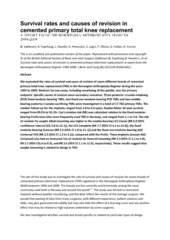| dc.contributor.author | Gøthesen, Øystein Johannes | en_US |
| dc.contributor.author | Espehaug, Birgitte | en_US |
| dc.contributor.author | Havelin, Leif Ivar | en_US |
| dc.contributor.author | Petursson, Gunnar | en_US |
| dc.contributor.author | Lygre, Stein Håkon Låstad | en_US |
| dc.contributor.author | Ellison, Peter | en_US |
| dc.contributor.author | Hallan, Geir | en_US |
| dc.contributor.author | Furnes, Ove | en_US |
| dc.date.accessioned | 2013-12-11T13:57:04Z | |
| dc.date.available | 2013-12-11T13:57:04Z | |
| dc.date.issued | 2013-05 | eng |
| dc.Published | Bone and Joint Journal 95-B(5): 636–642 | eng |
| dc.identifier.issn | 2049-4394 | |
| dc.identifier.uri | https://hdl.handle.net/1956/7596 | |
| dc.description.abstract | We evaluated the rates of survival and cause of revision of seven different brands of cemented primary total knee replacement (TKR) in the Norwegian Arthroplasty Register during the years 1994 to 2009. Revision for any cause, including resurfacing of the patella, was the primary endpoint. Specific causes of revision were secondary outcomes. Three posterior cruciate-retaining (PCR) fixed modular-bearing TKRs, two fixed non-modular bearing PCR TKRs and two mobilebearing posterior cruciate-sacrificing TKRs were investigated in a total of 17 782 primary TKRs. The median follow-up for the implants ranged from 1.8 to 6.9 years. Kaplan-Meier 10-year survival ranged from 89.5% to 95.3%. Cox’s relative risk (RR) was calculated relative to the fixed modularbearing Profix knee (the most frequently used TKR in Norway), and ranged from 1.1 to 2.6. The risk of revision for aseptic tibial loosening was higher in the mobile-bearing LCS Classic (RR 6.8 (95% confidence interval (CI) 3.8 to 12.1)), the LCS Complete (RR 7.7 (95% CI 4.1 to 14.4)), the fixed modular-bearing Duracon (RR 4.5 (95% CI 1.8 to 11.1)) and the fixed non-modular bearing AGC Universal TKR (RR 2.5 (95% CI 1.3 to 5.1)), compared with the Profix. These implants (except AGC Universal) also had an increased risk of revision for femoral loosening (RR 2.3 (95% CI 1.1 to 4.8), RR 3.7 (95% CI1.6 to 8.9), and RR 3.4 (95% CI 1.1 to 11.0), respectively). These results suggest that aseptic loosening is related to design in TKR. | en_US |
| dc.language.iso | eng | eng |
| dc.publisher | British Editorial Society of Bone and Joint Surgery | eng |
| dc.relation.ispartof | <a href="http://hdl.handle.net/1956/7597" target="blank">Computer Navigation in Total Knee Replacement Surgery. Effect on Outcome</a> | eng |
| dc.title | Survival rates and causes of revision in cemented primary total knee replacement. A report from the Norwegian Arthroplasty Register 1994–2009 | en_US |
| dc.type | Peer reviewed | |
| dc.type | Journal article | |
| dc.description.version | acceptedVersion | en_US |
| dc.rights.holder | Copyright 2013 The British Editorial Society of Bone & Joint Surgery | |
| dc.identifier.doi | https://doi.org/10.1302/0301-620x.95b5.30271 | |
| dc.identifier.cristin | 1029909 | |
| dc.source.journal | Bone and Joint Journal | |
| dc.source.40 | 95-B | |
| dc.source.14 | 5 | |
| dc.source.pagenumber | 636-642 | |
